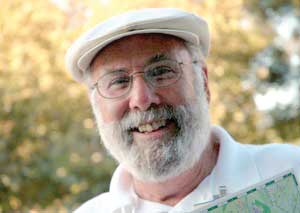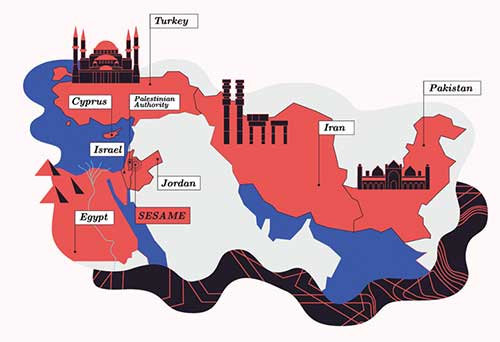SESAME Begins Operation and Reminisces of its Beginning
SESAME (Synchrotron-light for Experimental Science and Applications in the Middle East), the synchrotron light source in Jordan, began to store electron beams early in 2017. It’s administration is modeled on CERN and is under the umbrella of UNESCO. As this article is being written in late-December, 2017, the final steps of commissioning the first two X-ray beam lines are underway. By the time this is published the first scientific results may be achieved. The success of SESAME has led others, in Africa, to plan a similar facility by bringing together countries in Africa, the only habitable continent without a synchrotron light source.

I made the first suggestion for SESAME 20 years ago, and have been involved ever since with the many developments that have led to the beginning of research this year. I would like to summarize some key points in this 20 year history. This first suggestion, for what is now called SESAME, came at a meeting of the Scientific Advisory Committee for BESSY II, the 1.7 GeV light source that was funded in Berlin, Germany after the unification of East and West Germany as a successor to BESSY I, the 0.8 GeV light source that was in operation in West Berlin since 1982.
BESSY is an acronym for Berliner Elektronenspeicherring-Gesellschaft für Synchrotronstrahlung.
As is customary when a new light source facility is authorized and funded, an advisory committee is formed to review the plans, particularly since the concepts and technology associated with such light sources has continued to progress over the several decades, with new ideas enabling increased performance. I was asked to join the advisory committee for BESSY II in the early 1990s.
At a meeting of this advisory committee in September, 1997, when BESSY II was nearing completion, I asked about plans for BESSY I, which was still in full operation with about 30 beamlines, each equipped with a monochromator. The answer was that it was planned to sell BESSY I for scrap and clear out the building for other uses.
I was shocked by this waste of an extremely productive facility. I turned to my friend and colleague, Professor Gus Voss, the Technical Director of DESY, who was also on this advisory committee, and said that, rather than scrapping BESSY I, it should be offered as a gift to the Middle East, where, after upgrading, it would be the nucleus of a new light source facility in a part of the world that had none. I quickly calculated that superconducting wigglers could extend the spectral range to at least 10-15 KeV, the hard x-rays needed for many applications such as structural biology. We also expected that such a project would promote cooperation and peace in a troubled part of the world.
After my September 1997 suggestion to Voss that the decommissioned BESSY I facility could be the centerpiece of a new light source in the Middle East, Voss presented this idea to a November 1997 meeting of the CERN-based Middle East Scientific Collaboration (MESC) group in Torino, Italy. This meeting was organized by Tord Ekelof (Uppsala University) and included other key members of MESC (Sergio Fubini; Torino University, Herwig Schopper; past Director-General of CERN, Eliezer Rabinovici: Hebrew University, Israel).
Voss described the positive reception that he received from Middle East scientists at that MESC meeting in an email to me on November 14, 1997, immediately after the MESC meeting. This email included the following.
From Gus Voss on November 14, 1997
Dear Herman, remember, it was you who had this idea first and in all my conversations I do not fail to point this out. But even after having had this on my mind for several weeks now, I cannot see anything basically wrong with this idea.
I told you about my then upcoming week in Torino, actually this is what probably triggered your brainstorm. In Torino, actually a wonderful meeting with a number of brilliant talks (if you disregard mine) I talked to a number of Palestinians, Jordanians, Israelis, even Marockens and one Syrian. Also there were the originators of that meeting, of course, Ekelof from Sweden and Fubini from Italy. On all I very carefully tried out your idea. Nobody could see anything wrong, and quite often it struck a strong resonant response.
Having returned to Hamburg I first called Eberhard Jaeschke to make sure, he hadn`t given away his baby. Then I called Dr. H. Schunk, a very important administrator in our Bonn ministry. He sounded almost enthusiastic about this idea and told me, that he would approach Dr. Eschelsbacher, his boss, who is known to take problems of the Middle East close to his heart.
In addition, Voss informed Professor Adnan Badran, a Jordanian who was the Deputy Director for Science at UNESCO, about this idea. Badran responded to Voss on January 27, 1998 in a message which included the following:
“Dear Professor Gustav-Adolf Voss,
Thank you for your E-Mail of 17 December 1997 and your letter of 7 January 1998 concerning the Berlin Synchrotron Light Source BESSY I’s move to a country in the Middle East to eventually be a seed for a new research facility available to all scientists in the area. I also received another E-Mail from both Prof. Sami Mahmoud and Prof. Mohamoud Al-Kofahi, Senior Physicists as Yarmouk Univerisy, requesting me to develop contacts with you concerning BESSY I, an 800 MeV accelerator when it will be shut down after December 1999 and replaced by BESSY II: and to bring to your attention that Yarmouk University is interested to have these facilities on its campus and make this accelerator radiation laboratory open to all scientists in the Region and other parts of the World.
Jordan could be an ideal place for such an operation in Middle East for the following reasons:
- Availability of the critical mass of scientists in basic research in the areas of physics, chemistry, biology, medicine and material research. These scientists are distributed within 18 universities in the country and within driving distance.
- The availability of institutional infrastructure of research and development at the universities, the higher council for science and technology, and at the Royal Scientific Society.
- Geography and free access allow all scientists from the Region and other parts of the world to establish joint research activities around the high energy synchrotron accelerator.”
Gus then formed a team consisting of several people at BESSY (particularly Ernst Weihreter), me and others to work out a conceptual design report for BESSY Ia (the Green Book). This design used all of the BESSY I components, except the vacuum system. BESSY I was 62m in circumference with 4 straight sections, 2 of which were available for IDs. BESSY Ia was 101m in circumference with 6 straights, 4 of which could be used for IDs. By closing the magnet gap, the energy could be pushed from 0.8 to 1.0 GeV, where a 7T SC wiggler would provide a spectrum with a critical energy of 4.7 Kev, reaching much deeper into the hard x-ray spectral range. This conceptual design was presented at the international accelerator conference in Germany in 2000.
By the end of 1997, Voss informed the Deputy Director of UNESCO, Adnan Badran, the directors of BESSY I, and others of his support for this idea. He also made Herwig Schopper aware of this idea.
This led to a series of UNESCO sponsored meetings resulting in the formation of the Interim SESAME Council, with Schopper as president. In 2000 Voss, together with Kamal Araj, organized a 10 day SESAME accelerator school, at which 50 Middle East scientists and engineers were introduced to accelerators. Several of these are now on the SESAME staff, and others are on the staff of other light sources.
Voss also led a group evaluating proposals from 6 Middle East countries to host SESAME, leading to the choice of Jordan as the host country. He continued to support SESAME until his death in Oct. 2013.
In its evaluation of SESAME in May 2002, the Executive Board of UNECO said that SESAME was “a quintessential UNESCO project combining capacity building with vital peace-building through science” and “a model project for other regions”.
Another view of the origins of SESAME is given by Eliezer Rabinovici in a recent issue of the newsletter of the APS Division of the Physics of Beams (DPB). See; SESAME: A Personal Point of View; https://www.aps.org/units/dpb/newsletters/upload/fall17.pdf

The current members of SESAME are Cyprus, Egypt, Iran (Islamic Republic of), Israel, Jordan, Pakistan, the Palestinian Authority, and Turkey.
During his scientific career Herman Winick played a strong leadership role in the development of synchrotron radiation sources and research at Stanford University and around the world. Scientifically he is now focusing largely on SESAME, a project he began together with Gus Voss (DESY) in 1997. In 2007 he was chair of the APS Forum on International Physics (FIP). In 2009 he was elected to represent FIP on the APS Council. In 2005 he received the Heinz R. Pagels Human Rights of Scientists Award from the New York Academy of Sciences. In 2010 he received the Andrei Sakharov Prize from the American Physical Society.
